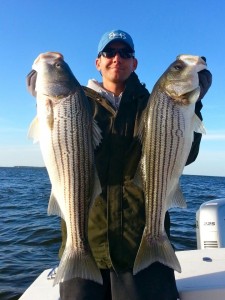 I’ve been lying low over the past couple of weeks waiting out the craziness. Most of my fishing has been in out-of-the-way places far from the madding crowds. Radios blaring, airplanes buzzing, stereos thumping, outboards droning, helicopters whirring, sirens wailing – Wow! Boat shows, trolling tournaments, and sailing regattas make the main stem of the Chesapeake very noisy. The Bay is fully awake from her winter slumber and the crowds are back in force. While we each enjoy the water in our preferred ways, to my thinking fishing should include elements of solitude and stealth. I’ve mentioned before that I’d rather pick up aluminum cans at rush hour along I-95 than try to pick off rockfish in the main channel on a busy trolling weekend. I prefer to look off the beaten path for places where I can tune-in to something a little more pleasing than the clamorous dissonance of the masses.
I’ve been lying low over the past couple of weeks waiting out the craziness. Most of my fishing has been in out-of-the-way places far from the madding crowds. Radios blaring, airplanes buzzing, stereos thumping, outboards droning, helicopters whirring, sirens wailing – Wow! Boat shows, trolling tournaments, and sailing regattas make the main stem of the Chesapeake very noisy. The Bay is fully awake from her winter slumber and the crowds are back in force. While we each enjoy the water in our preferred ways, to my thinking fishing should include elements of solitude and stealth. I’ve mentioned before that I’d rather pick up aluminum cans at rush hour along I-95 than try to pick off rockfish in the main channel on a busy trolling weekend. I prefer to look off the beaten path for places where I can tune-in to something a little more pleasing than the clamorous dissonance of the masses.
Since the striped bass spawn is winding down on the Chesapeake Bay, I thought it might be interesting to take a look at some post-spawn patterns. When stripers come off the spawning grounds, they’re usually hungry. If you can find them, they’re pretty easy to catch. Ah, but finding them, there’s the rub. Where should you look?
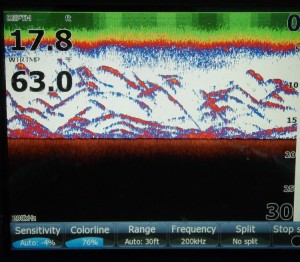 Since the Spring turnover has happened in most areas of the Chesapeake Bay, the water is about the same temperature top to bottom. That means a definite pattern change because fish are moving up to shallow-water comfort zones. While there is still some action around warm water discharges and plenty of solitary fish moving up and down the channel, actively feeding fish are more likely to school up in areas where the water is warmest. They will usually feed close to the bottom, but they will occasionally round up bait and blitz on the surface. Rockfish prefer water temperatures in the mid-60s. As of today, the main stem of the Bay is about 61-degrees but if you know where to look, you can find water in the mid-60s and that’s where the fish are.
Since the Spring turnover has happened in most areas of the Chesapeake Bay, the water is about the same temperature top to bottom. That means a definite pattern change because fish are moving up to shallow-water comfort zones. While there is still some action around warm water discharges and plenty of solitary fish moving up and down the channel, actively feeding fish are more likely to school up in areas where the water is warmest. They will usually feed close to the bottom, but they will occasionally round up bait and blitz on the surface. Rockfish prefer water temperatures in the mid-60s. As of today, the main stem of the Bay is about 61-degrees but if you know where to look, you can find water in the mid-60s and that’s where the fish are.
The shallower the water, the quicker it is warmed by the sun. My casting destination of choice this time of year is the rivers and shallow bays off the main stem of the Chesapeake. The essential elements for a good fishing spot are current, cover, presence of bait, and an escape route to deeper water. Find a place with all that, and you will find rockfish. Since current and cover are the easiest to recognize, start there. Look for piers, docks, rocks, and pilings in areas where the current sweeps through quickly. Shoreline is great, but underwater humps and ledges can also be good. Don’t disregard the areas near boat ramps, docks, or bridges. Many fishermen cruise right by the very best fishing locations because they’re very close to where they put their boats in.
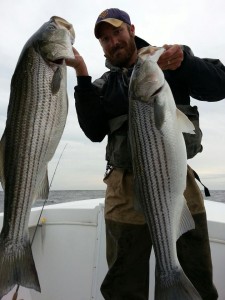 Areas close to the mouths of rivers can be especially good because the water coming out of the shallows is generally warmer. Because of this, outgoing tides can result in excellent fishing around river mouths. An incoming tide is a good time to look at deeper spots like humps and ledges just inside or just outside the mouths of the rivers. I’ve been getting good reports from the western shore from fishermen who are working this very pattern. My fishing partners and I have also been successful around the mouths of the east side rivers and creeks.
Areas close to the mouths of rivers can be especially good because the water coming out of the shallows is generally warmer. Because of this, outgoing tides can result in excellent fishing around river mouths. An incoming tide is a good time to look at deeper spots like humps and ledges just inside or just outside the mouths of the rivers. I’ve been getting good reports from the western shore from fishermen who are working this very pattern. My fishing partners and I have also been successful around the mouths of the east side rivers and creeks.
Right now, I’m finding fish holding very close to the bottom in water 4 to 20′ deep. A half- or three-quarter-ounce 6″ soft plastic jig worked along the bottom near a rocky point has been great. If I’m working a point or rip where the water is 6′ deep or less, I’ll switch up to a RattleTrap or some other swimming lure, preferably something that doesn’t hang up too often. Bucktails and spoons will also work in shallow water/high current situations. If boat fishing isn’t always in the picture, you can just as easily catch fish from the shore right now, so don’t forget about that rocky point you drive by every day on your way to work. There is probably fish there.
In another week or so we should be well into spring topwater fishing. You can catch on topwater plugs now, but the action will really heat up once water temperatures are consistently above 65-degrees. Start with spooks on calm days but move up to a chugger when it’s windy or when fish are feeding aggressively. The bigger the lure the better. I like Lonely Anglers, Heddon Super Spooks, and Stillwater SmackIts. Follow the same pattern for locating a good fishing spot, and try to keep your lure in the strike zone as long as possible. The best way to fish a point or rip with a topwater plug is to position yourself down-stream and cast into the current. You want your lure moving with the current and across the rip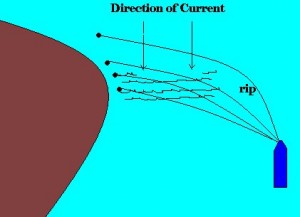 as long as possible. Strikes are most likely to occur right where you see the ripples change along the rip. Check the casting diagram to the right .
as long as possible. Strikes are most likely to occur right where you see the ripples change along the rip. Check the casting diagram to the right .
Last week, I took some time off to fish with my brother, Creig. Rich Jenkins joined us one day. Our best fishing followed the pattern I’ve described above. There was no lack of keepers and we had a couple of fish in the high 30-inch range. We also found some breaking fish and even shad near the warm water discharges. I fished again with Rich and Jamie Sunday night and we also found fish in very shallow water around the mouths of the rivers. Reports are consistent from the west side rivers as well. Good luck if you go and please keep me in your loop. I always reciprocate with fishing reports. Look for me on Facebook or stay tuned to ChesapeakeLightTackle.com for the latest.




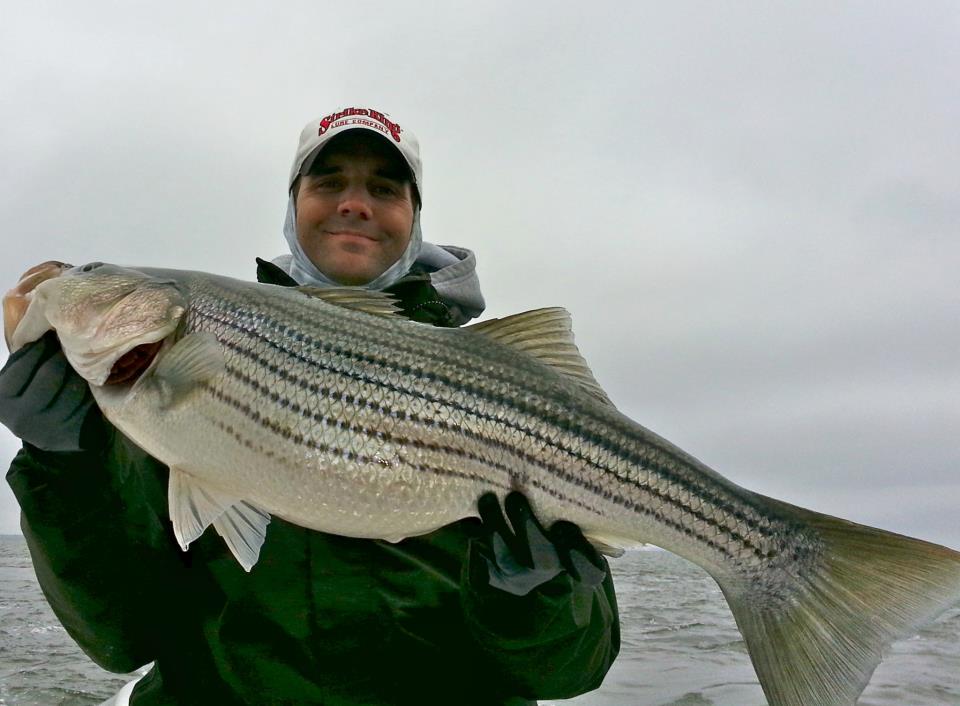
Nice write up, Shawn. I always look forward to reading your reports.
I guess it’s time to leave those trout, bluegill and LMB alone and get back out on the bay. I’ve been like you, avoiding the crowds and ridiculous long runs. Time to fish the shallows! Sea Ya out there.
Mike
shawn, i topwater fished today from 7 to 830 with no blowups. i did however see tons of menhaeden jumping. my cast net is in north carolina though because i wasnt expecting the menhaeden to be in the shallows already. i also tried bucktails and rattles traps tongiht. then again i was fishing in selby bay , not my other spot :). i went kayak fishing today in ramsey lake and caught alot of jumbo perch on my ultralight, that was alot of fun! they hit a 1/8 ounce jighead with a 2 inch chartreuse sparkle twister tail on a small spinner.
Great report. I never really look too much for rock in the 15-20 foot zone. I guess I better start looking haha!
Great write-up as usual my friend..the next few weeks are always great..lot’s of options for locations to fish which makes it even better..see ya soon
If I told you what we are catching along the western shorelines they’d shoot me. Let’s just say check plus.
^^^^ yeah. i know what your talking about . ive been slaying them at that spot with spro bucktails and white twister tails. the action can get red hot at times there
These type of techniques have been working for us. Current, and structure in 10-15′ with 1/2oz to 3/4oz and a little stealth. Unfortunately they’ve all been small. Thanks for your posts! They have helped me tons with light tackle, we catch almost everytime instead of wasting hours trolling around.
The 6-inch BKD’s with the 1/2 ounce weights are more my speed, as I have not had much luck with the 10-ouncers and heavier jig heads. This was an informative write up, and should help me. Thanks for putting it together.
Don
thanks Shawn – I am going to give it a go this Sunday morning early. Do you have an email address….what’s the best way of “keeping you in the loop” privately?
Your reports always get me ramped up..good stuff Mr.Kimbro.
Got out twice since Sunday and followed your advice. Caught 2 low 20″ers on a bar at the mouth of a western shore river on a rattletrap & a suspending X Rap. Yesterday fished pilings with a 6″ BKD & got one fat 26″ fish. Keep the advice coming….I’m listening.
We were casting lures off the rocks of Gibson Island last night with moderate success when two guys start teeing off golf balls at us…
shawn I am really having a difficult time trying to find a suitable baitcasting rod for jig fishing.they all seem to be either too stiff or too limber.Light weight and quality are a must.Any brand name and action would be extremely helpfull.By the way I picked up 3 quality fish in eastern bay sat june 1st all returned in good condition
Replied below:
Depends on how much you want to spend. In the $100.00 range look at the St. Croix Mojo Bass series. MBC66MF is the best jigging model. (Medium power, 6’6″, fast action.) You can usually find that rod at the bait shops or big box stores to get an idea of how it feels. Use its length, speed, and action as a model for more expensive rods. Generally, you get what you pay for. The weight goes down and the sensitivity increases (a little) as you move up in price.
Hey Shawn thanks for the starting pointon your style of jigging rod.Ihave jigged many years using spinning gear and tandem rigged feather jigs around structure.I am an old dog but love new tricks.Thanks again